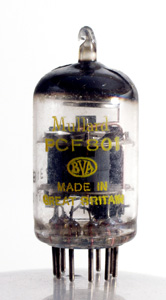|
Triode Pentode for Television Tuners and IF Amplifiers

Mullard PCF801.
The PCF801 is a new Mullard triode-pentode for television tuners. The performance and versatility of the valve make it an excellent choice for television receivers designed for both VHF and UHF reception. It can function as an oscillator-mixer in VHF tuners and as an IF amplifier following a UHF tuner.
Two frame grids are incorporated in the valve: the triode grid and the pentode control grid, which has also been designed with a variable-mu characteristic. Outstanding properties of the PCF801 are small inter-electrode capacitances, a high conversion conductance and a remote cut- off characteristic.
As an oscillator-mixer, the pentode section of the PCF801 operates as the mixer and the triode section as the oscillator. In the triode section, use of the frame grid ensures an oscillator performance that is largely independent of supply voltage variations. In the pentode section, a conversion conductance of 5mA/V is achieved with an RMS oscillator signal amplitude of only 1.6V. Because of the small cross-capacitance between the triode anode and pentode control grid (<0.010pF), the oscillator frequency shift when bias is applied to the mixer control grid is kept to a minimum.
The control grid of the pentode section of the PCF801 has a variable-mu characteristic. This section is therefore very suitable for application as a controlled IF amplifier. Because of the remote cut-off characteristic, large IF signals from a UHF tuner can be handled without risk of cross-modulation or over-modulation occurring. The small anode to control-grid capacitance of the section (0.009pF) eliminates feedback of the IF signal to the RF band-pass filter, so that difficulties in the adjustment of this filter are avoided.
|